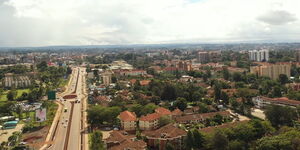Motorists in Nairobi on Sunday, November 28, were stranded on Mombasa Road following the flooding of sections of the Highway.
A number of vehicles were pictured submerged in water owing to the heavy rainfall witnessed in the capital on Saturday, extending to Sunday morning.
Driving through floods or still waters can cause damage on vehicles that may be costly in terms of repair. Kenyans.co.ke has established several ways in which motorists can prevent incurring loss when driving through flooded waters:
1. Avoid driving in flooded areas
Car expert, Miller Kyalo, recommend that drivers should avoid driving on flooded sections of the road at all costs. Any water, still or running with a depth of more than 10centimetres is a ticking time bond.
Instead, he advise drivers, where possible, to park their vehicles on the side of the road until the the water level falls. With the help of the internet, they can seek alternative routes to get to their destinations.
2. Keep driving, do not stop
In the event that motorists are caught up in flooded waters, they are encouraged to keep stepping on the accelerator. This prevents water from entering the engine through the exhaust pipe, or through the air-intake pipe, which could suck up the water into the engine.
"Even if you are caught up in traffic, keep raving your engine," Kyalo added.
He explained that water is incompressible unlike oil. If it enters the engine, it leads to compression issues since the water has no where to go. Eventually, piston rods will begin to bend and break.
Motorists should therefore keep moving at a slow yet steady pace.
3. Always drive in first gear
In addition, motorists should always drive in first gear. This is because running or still waters have a high-level resistance.
Cars need a powerful gear to overcome this resistance, which is usually the first or reverse gear. The gears can be engaged automatically or manually depending on the type of transmission of the vehicle.
4. Step on the Brakes
Drivers are encouraged to step on the brakes as they wade through the waters. According to Inquirer Mobility, occasionally stepping on the brakes ensures they are still functional.
"Slightly step on the brakes, this is to ensure that they are in place in case anything happens," Ardie Lopez stated.
Lopez explained that this helps dry the break pads thus increasing the grip on the tyres.
5. Incase You Stop
In the event that your engine stops running, do not turn it on. This will only suck the water into the vehicle causing instant damage. Instead, one should seek help from a tow company or other road users to help push the vehicle to the side of the road.
Kyalo also recommends that anyone who drives through flooded waters should visit a mechanic for a vehicle check up.












